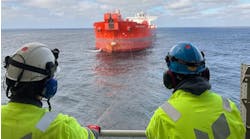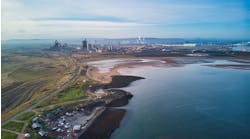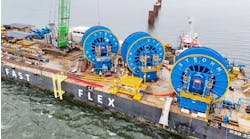Ian Anderson
Camcon Oil
With operators looking to squeeze every last drop of oil and gas from offshore fields, the focus on enhanced oil recovery techniques and, in particular, artificial gas lift, is likely to gain considerable prominence this year.
Furthermore, the targets set by many of the world’s operators are ambitious. Norwegian operator, Statoil, for example, has a target recovery factor offshore of 65% for platform operated fields and 55% for subsea-operated fields and Saudi Aramco’s President and CEO Khalid A. Al Falih has established a target recovery rate of 70% from Aramco’s major existing fields – some of which are offshore.
The fact remains, however, that we have a long way to go to achieve these rates. Norwegian fields lead with a current average recovery rate of 46%. Many other fields, however, are in the low 30% range and the really deepwater fields will be lucky to achieve recovery rates of 10 to 15%.
Operators in the past have often been too quick to leave existing fields when recovery rates reached around 30%. More often than not, this was due to the quest for “new oil.” With “new oil” becoming difficult to access and extract, there is renewed focus on existing fields.
How many times have we heard that the North Sea is running on empty, for example, when it is clear that there’s much more to seek? Short-term production strategies have been king too often.
Offshore information challenge
Another important factor to consider in the quest for increased recovery rates is the widening recovery gap between topside and subsea wells. Subsea wells typically generate average recovery rates of up to 15% less than their topside counterparts.
Why is this? It is difficult to generate reliable and accurate subsea reservoir information on key variables, such as temperature, gas flow, or the amount of water or sand in the production flow.
In addition, there are also the costs and risks of subsea intervention. The ability to carry out frequent well interventions generally increases oil and gas recovery rates, and yet many of the subsea christmas trees in regions such as the Gulf of Mexico can be extremely complicated.
This lack of information can impact enhanced oil recovery (EOR) techniques with little information on potential well instability – something that can be due to a number of reasons from water breakthrough to slugging to increased pressures in the well.
While well instability rarely results in catastrophe it can be a major impediment to both recovery rates and EOR techniques – particularly artificial gas lift.
Artificial lift technologies
For offshore EOR, and, in particular, artificial lift, techniques often come to prominence either during secondary recovery or after tertiary recovery methods such as steam and chemical injection have been exhausted. Primary recovery under natural pressure usually allows about 20% of the oil to be recoverable, putting a considerable onus on the follow-up methods.
Spears & Associates’ October 2009 Oilfield Market Report estimates the global artificial lift market at $5.8 billion in 2009, with 58% of this ($3.35 billion) down to electrical submersible pumps, which are used in a variety of different fields from the deep waters of the Gulf of Mexico to the oil sands of Canada.
Other techniques include rod lift (over $1 billion); progressing cavity pumps (PCP) with a 2009 market value of $470 million; and hydraulic pumps at $110 million.
One of the most common forms of artificial lift, however, is gas injection. While having only 4% of the 2009 artificial lift market according to Spears & Associates, the technique continues to grow.
Artificial gas lift consists of injecting gas, such as CO2, natural gas, or nitrogen, into the production tubing to reduce the impact of the hydrostatic pressure where the reservoir pressures are not sufficient to force the hydrocarbons to the surface.
There are a number of advantages to this artificial lift technique offshore – namely that it can be applied in a wide variety of well conditions; can handle high volume and high-pressure/high-temperature wells; and that the side pocket mandrel and gas lift injection valves allow a deeper gas injection into the tubing. The reliability of gas lift makes it attractive to offshore operators.
Today, offshore artificial gas lift is used with greater frequency in the Gulf of Mexico. One example, the Amberjack oil field in the Mississippi Canyon, increased production 600 boe/d after gas lift optimization, representing a 7% production increase (Source: SPE 84166, SPE Annual Technical Conference and Exhibition, Denver, Colorado, October 2003).
While there are clear benefits to artificial gas lift for offshore operators, the technology remains a work in progress – mainly due to the lack of subsea information discussed earlier.
Too often, operators have little or no information on pressure and temperatures at the point of gas injection, and little control or flexibility in altering injection rates as production variables change. In fast moving offshore fields, where field and well conditions can fluctuate dramatically, this is a significant disadvantage.
Furthermore, with traditional gas lift, the primary method of gas injection is the “side pocket mandrel” configured completions where wireline interventions are used to change the operating valve when injection rate changes are necessary. This can be a long, cumbersome process that can damage existing infrastructure (if the wire snaps, for example) and halt production while a new side mandrel unit is installed.
Here, the dangers of well instability also can come to the fore, with artificial gas lift actually increasing the probability of dramatic flow fluctuations and unpredictable surges in liquid and gas production rates.
The key question is: what if the artificial gas lift process was closely monitored at the point of gas injection onwards? And, relatedly: How can greater digital intelligence be incorporated into offshore artificial gas lift operations?
Digitization of artificial gas lift
One solution is a digital artificial lift system that addresses many of these issues.
Known as APOLLO, it is based around binary actuation technology (BAT), which also has applications for the automotive, manufacturing, and life sciences industries. Central to the technology is a low energy pulse control which signals to switch an actuator between two stable positions to digitally operate a valve. Particular benefits include high switching speed and low power consumption.
The downhole portion of the digital artificial gas lift system.
This technology now is customized for artificial gas lift with a seemingly simple but technically advanced concept with implications for offshore artificial lift.
The actuator is coupled to a gas flow control valve to enable that valve to be opened or closed remotely, eliminating the need for side mandrel units and wireline intervention. The series of digitally operated valves then enable the real-time setting of injection rates, with the technology able to be fitted straight into the tubing so it can be deployed more flexibly – in fish-hook wells or where there are highly deviated sections, for example.
Offshore operators will be able to vary injection rates in real-time without wireline or slickline intervention, meaning no lost uptime, continuous production, and reduced risk. Furthermore, as opposed to conventional gas lift where the operator has no information about operating conditions at the point of injection, the live information allows operators to optimize extraction conditions, minimize gas usage across the reservoir, enhance oil recovery, and protect the wells from instability.
In short, digital artificial lift provides above ground control over the downhole gas lifting process and eliminates the need for well intervention. The ability to remotely alter conditions without intervention should enable operators to address the performance gap between topside and subsea wells. The ability to monitor remotely downhole conditions as well as to alter injection conditions without the need to touch the wellhead increases operational flexibility.
Current status
Trials of the new solutions are under way by a major oil operator who is providing support and access to its rig and multi-phase test facilities. Test results are expected in the near future.
Manufacturing and distribution channels also are taking shape. Camcon has a manufacturing agreement with Ultra Electronics, Manufacturing & Card Systems (Ultra CEMS) which delivers virtually unbreakable products to the aerospace, energy, defence, nuclear, and transportation industries which will stand us in good stead as we look to deploy downhole.
Offshore Articles Archives
View Oil and Gas Articles on PennEnergy.com





